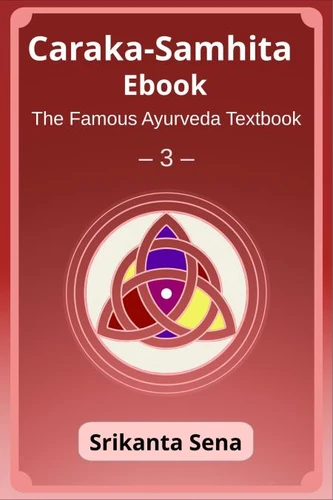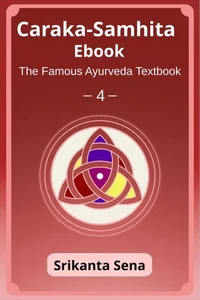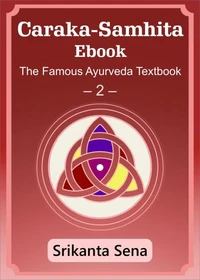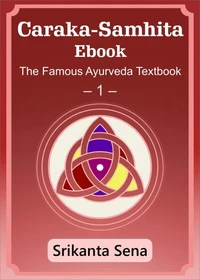Caraka - Samhita Ebook. Caraka - Samhita Ebook, #3
Par :Formats :
Disponible dans votre compte client Decitre ou Furet du Nord dès validation de votre commande. Le format ePub est :
- Compatible avec une lecture sur My Vivlio (smartphone, tablette, ordinateur)
- Compatible avec une lecture sur liseuses Vivlio
- Pour les liseuses autres que Vivlio, vous devez utiliser le logiciel Adobe Digital Edition. Non compatible avec la lecture sur les liseuses Kindle, Remarkable et Sony
 , qui est-ce ?
, qui est-ce ?Notre partenaire de plateforme de lecture numérique où vous retrouverez l'ensemble de vos ebooks gratuitement
Pour en savoir plus sur nos ebooks, consultez notre aide en ligne ici
- FormatePub
- ISBN8215614709
- EAN9798215614709
- Date de parution10/08/2024
- Protection num.pas de protection
- Infos supplémentairesepub
- ÉditeurWMG Publishing
Résumé
The Caraka Samhita is the oldest and best known classics of Ayurveda. It was written more than two thousand years ago by the physician and sage Caraka in the Sanskrit language as a textbook for the study of Ayurveda. To this day, the Caraka Samhita is the indispensable basic work for anyone who wants to apply Ayurveda as a physician, therapist or privately. This is Volume 3 of Caraka-Samhita Ebook.
There are four volumes in total containing the eight main parts of Caraka-Samhita: 1. Sutrasthanam (Fundamentals, Basic Principles of Ayurveda)2. Nidanasthanam (Diagnostics)3. Vimanasthanam (Specific characteristics and aspects of do?as, diseases, patients, etc.)4. Sarirasthanam (Anatomy, physiology, conception, pregnancy and birth)5. Indriyasthanam (Signs of imminent death)6. Cikitsasthanam (Therapeutics, 33 chapters)7.
Kalpasthanam (Preparations for emesis and purgation)8. Siddhisthanam (Pañcakarma therapies) Each volume contains an appendix with a list of references, a guide to the pronunciation of Sanskrit, a list of plants, a Sanskrit glossary with ayurvedic terms and names of persons mentioned in the book, and a list of tables. In vol. 3 there is also a list of Ayurvedic drugs, preparations and dietetic formulations mentioned and described in the chapters of the Cikitsasthanam.*******************************************************Table of contents of volume 3 (condensed version without subchapters): IntroductionCikitsasthanam (Therapeutics, 33 chapters)- 1 Rasayana (rejuvenation therapy)- 2 Vajikara?a (fertility therapy)- 3 Jvara (types of fever)- 4 Raktapitta (haemorrhage)- 5 Gulma (phantom tumour)- 6 Prameha (persistent urinary disorders)- 7 Ku??ha (persistent skin diseases)- 8 Rajayak?ma (consumption)- 9 Unmada (mental disorders)- 10 Apasmara (epilepsy)- 11 K?ata-k?i?a (phthisis caused by injury)- 12 Svayathu (oedema)- 13 Udara (abdominal diseases)- 14 Arsa (haemorrhoids)- 15 Graha?ido?a (digestive disorders)- 16 Pa??uroga (anaemia)- 17 Hikka svasa (hiccups and dyspnoea)- 18 Kasa (cough, bronchitis)- 19 Atisara (diarrhoea)- 20 Chardi (vomiting)- 21 Visarpa (erysipelas and herpes zoster)- 22 T???a (morbid thirst)- 23 Vi?a (poisoning)- 24 Madatyaya (alcohol poisoning)- 25 Dvivra?iya (wounds and ulcers)- 26 Trimarmaya (diseases of the head, heart and urinary system)- 27 Urustambha (stiffness of the thighs)- 28 Vatavyadhi (vata diseases)- 29 Vataso?ita (gout and arthritis)- 30 Yonivyapat (diseases of the female genital tract)- 31 Eight seminal defects and impotence- 32 Breast milk defects- 33 Therapeutics - Final considerationsAppendix- List of references- Instructions for pronouncing Sanskrit- List of plants- Glossary of Ayurvedic terms- Medicines and dietary preparations- List of tables
There are four volumes in total containing the eight main parts of Caraka-Samhita: 1. Sutrasthanam (Fundamentals, Basic Principles of Ayurveda)2. Nidanasthanam (Diagnostics)3. Vimanasthanam (Specific characteristics and aspects of do?as, diseases, patients, etc.)4. Sarirasthanam (Anatomy, physiology, conception, pregnancy and birth)5. Indriyasthanam (Signs of imminent death)6. Cikitsasthanam (Therapeutics, 33 chapters)7.
Kalpasthanam (Preparations for emesis and purgation)8. Siddhisthanam (Pañcakarma therapies) Each volume contains an appendix with a list of references, a guide to the pronunciation of Sanskrit, a list of plants, a Sanskrit glossary with ayurvedic terms and names of persons mentioned in the book, and a list of tables. In vol. 3 there is also a list of Ayurvedic drugs, preparations and dietetic formulations mentioned and described in the chapters of the Cikitsasthanam.*******************************************************Table of contents of volume 3 (condensed version without subchapters): IntroductionCikitsasthanam (Therapeutics, 33 chapters)- 1 Rasayana (rejuvenation therapy)- 2 Vajikara?a (fertility therapy)- 3 Jvara (types of fever)- 4 Raktapitta (haemorrhage)- 5 Gulma (phantom tumour)- 6 Prameha (persistent urinary disorders)- 7 Ku??ha (persistent skin diseases)- 8 Rajayak?ma (consumption)- 9 Unmada (mental disorders)- 10 Apasmara (epilepsy)- 11 K?ata-k?i?a (phthisis caused by injury)- 12 Svayathu (oedema)- 13 Udara (abdominal diseases)- 14 Arsa (haemorrhoids)- 15 Graha?ido?a (digestive disorders)- 16 Pa??uroga (anaemia)- 17 Hikka svasa (hiccups and dyspnoea)- 18 Kasa (cough, bronchitis)- 19 Atisara (diarrhoea)- 20 Chardi (vomiting)- 21 Visarpa (erysipelas and herpes zoster)- 22 T???a (morbid thirst)- 23 Vi?a (poisoning)- 24 Madatyaya (alcohol poisoning)- 25 Dvivra?iya (wounds and ulcers)- 26 Trimarmaya (diseases of the head, heart and urinary system)- 27 Urustambha (stiffness of the thighs)- 28 Vatavyadhi (vata diseases)- 29 Vataso?ita (gout and arthritis)- 30 Yonivyapat (diseases of the female genital tract)- 31 Eight seminal defects and impotence- 32 Breast milk defects- 33 Therapeutics - Final considerationsAppendix- List of references- Instructions for pronouncing Sanskrit- List of plants- Glossary of Ayurvedic terms- Medicines and dietary preparations- List of tables
The Caraka Samhita is the oldest and best known classics of Ayurveda. It was written more than two thousand years ago by the physician and sage Caraka in the Sanskrit language as a textbook for the study of Ayurveda. To this day, the Caraka Samhita is the indispensable basic work for anyone who wants to apply Ayurveda as a physician, therapist or privately. This is Volume 3 of Caraka-Samhita Ebook.
There are four volumes in total containing the eight main parts of Caraka-Samhita: 1. Sutrasthanam (Fundamentals, Basic Principles of Ayurveda)2. Nidanasthanam (Diagnostics)3. Vimanasthanam (Specific characteristics and aspects of do?as, diseases, patients, etc.)4. Sarirasthanam (Anatomy, physiology, conception, pregnancy and birth)5. Indriyasthanam (Signs of imminent death)6. Cikitsasthanam (Therapeutics, 33 chapters)7.
Kalpasthanam (Preparations for emesis and purgation)8. Siddhisthanam (Pañcakarma therapies) Each volume contains an appendix with a list of references, a guide to the pronunciation of Sanskrit, a list of plants, a Sanskrit glossary with ayurvedic terms and names of persons mentioned in the book, and a list of tables. In vol. 3 there is also a list of Ayurvedic drugs, preparations and dietetic formulations mentioned and described in the chapters of the Cikitsasthanam.*******************************************************Table of contents of volume 3 (condensed version without subchapters): IntroductionCikitsasthanam (Therapeutics, 33 chapters)- 1 Rasayana (rejuvenation therapy)- 2 Vajikara?a (fertility therapy)- 3 Jvara (types of fever)- 4 Raktapitta (haemorrhage)- 5 Gulma (phantom tumour)- 6 Prameha (persistent urinary disorders)- 7 Ku??ha (persistent skin diseases)- 8 Rajayak?ma (consumption)- 9 Unmada (mental disorders)- 10 Apasmara (epilepsy)- 11 K?ata-k?i?a (phthisis caused by injury)- 12 Svayathu (oedema)- 13 Udara (abdominal diseases)- 14 Arsa (haemorrhoids)- 15 Graha?ido?a (digestive disorders)- 16 Pa??uroga (anaemia)- 17 Hikka svasa (hiccups and dyspnoea)- 18 Kasa (cough, bronchitis)- 19 Atisara (diarrhoea)- 20 Chardi (vomiting)- 21 Visarpa (erysipelas and herpes zoster)- 22 T???a (morbid thirst)- 23 Vi?a (poisoning)- 24 Madatyaya (alcohol poisoning)- 25 Dvivra?iya (wounds and ulcers)- 26 Trimarmaya (diseases of the head, heart and urinary system)- 27 Urustambha (stiffness of the thighs)- 28 Vatavyadhi (vata diseases)- 29 Vataso?ita (gout and arthritis)- 30 Yonivyapat (diseases of the female genital tract)- 31 Eight seminal defects and impotence- 32 Breast milk defects- 33 Therapeutics - Final considerationsAppendix- List of references- Instructions for pronouncing Sanskrit- List of plants- Glossary of Ayurvedic terms- Medicines and dietary preparations- List of tables
There are four volumes in total containing the eight main parts of Caraka-Samhita: 1. Sutrasthanam (Fundamentals, Basic Principles of Ayurveda)2. Nidanasthanam (Diagnostics)3. Vimanasthanam (Specific characteristics and aspects of do?as, diseases, patients, etc.)4. Sarirasthanam (Anatomy, physiology, conception, pregnancy and birth)5. Indriyasthanam (Signs of imminent death)6. Cikitsasthanam (Therapeutics, 33 chapters)7.
Kalpasthanam (Preparations for emesis and purgation)8. Siddhisthanam (Pañcakarma therapies) Each volume contains an appendix with a list of references, a guide to the pronunciation of Sanskrit, a list of plants, a Sanskrit glossary with ayurvedic terms and names of persons mentioned in the book, and a list of tables. In vol. 3 there is also a list of Ayurvedic drugs, preparations and dietetic formulations mentioned and described in the chapters of the Cikitsasthanam.*******************************************************Table of contents of volume 3 (condensed version without subchapters): IntroductionCikitsasthanam (Therapeutics, 33 chapters)- 1 Rasayana (rejuvenation therapy)- 2 Vajikara?a (fertility therapy)- 3 Jvara (types of fever)- 4 Raktapitta (haemorrhage)- 5 Gulma (phantom tumour)- 6 Prameha (persistent urinary disorders)- 7 Ku??ha (persistent skin diseases)- 8 Rajayak?ma (consumption)- 9 Unmada (mental disorders)- 10 Apasmara (epilepsy)- 11 K?ata-k?i?a (phthisis caused by injury)- 12 Svayathu (oedema)- 13 Udara (abdominal diseases)- 14 Arsa (haemorrhoids)- 15 Graha?ido?a (digestive disorders)- 16 Pa??uroga (anaemia)- 17 Hikka svasa (hiccups and dyspnoea)- 18 Kasa (cough, bronchitis)- 19 Atisara (diarrhoea)- 20 Chardi (vomiting)- 21 Visarpa (erysipelas and herpes zoster)- 22 T???a (morbid thirst)- 23 Vi?a (poisoning)- 24 Madatyaya (alcohol poisoning)- 25 Dvivra?iya (wounds and ulcers)- 26 Trimarmaya (diseases of the head, heart and urinary system)- 27 Urustambha (stiffness of the thighs)- 28 Vatavyadhi (vata diseases)- 29 Vataso?ita (gout and arthritis)- 30 Yonivyapat (diseases of the female genital tract)- 31 Eight seminal defects and impotence- 32 Breast milk defects- 33 Therapeutics - Final considerationsAppendix- List of references- Instructions for pronouncing Sanskrit- List of plants- Glossary of Ayurvedic terms- Medicines and dietary preparations- List of tables







